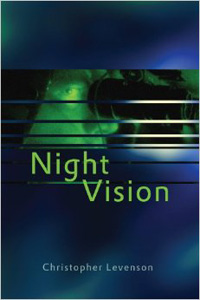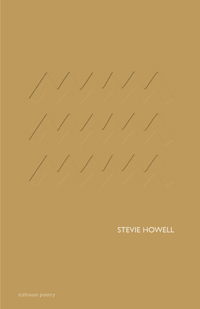Reviews
Poetry Reviews by Timothy Brownlow
Christopher Levenson, Night Vision (Toronto: Quattro, 2014). Paperbound, 103 pp., $18.
Stevie Howell, [SHARPS] (Fredericton: Goose Lane, 2014). Paperbound, 87 pp., $19.95.
 Christopher Levenson is at his best in a poem such as “Tafelmusik,” in which a cleverly controlled extended simile, starting with “As in…” compares a performance by a string quartet to an intimate dinner party:
Christopher Levenson is at his best in a poem such as “Tafelmusik,” in which a cleverly controlled extended simile, starting with “As in…” compares a performance by a string quartet to an intimate dinner party:
Soon now the tempo quickens,
out of the air we pluck
uneasy resonance, a pizzicato
counterpoint, until our hosts’ continuo
with a perfectly timed intervention
eases us, conducts us gently back
into adagios, with maybe a searching question
we must pause to accommodate…
“An die Musik” concludes with a fine passage: “It is the human voice claims us, world music telling us / we are one beyond language, and for a while at least / can abandon our sadness for joy.” The tone here is a welcome relief from that of many of the other poems, in which there is a stoic refusal to let the heart leap up. There is also the implication that music is the more universal art. This is a dispiriting admission for a dedicated poet to make. Good poetry, let alone great poetry, has always aspired to the condition of music, to perform a world music, in spite of the limitations of language. Levenson has stated elsewhere that he resists the concept of “inspiration,” but in many poems one feels that this resistance unnecessarily clips his wings. Here, with the theme of music, he can spread his wings in ways that show he has powers in reserve, and seasoned technique to express them.
On the whole, this reader finds that the least successful poems are the more directly political ones, including many of those in the first two parts of the book. It is in the third section that Levenson performs the broader function of the poet in Seamus Heaney’s sense of providing a “redress,” not just to external conditions (usually dire), but, as Heaney wrote in “Crediting Poetry” (his Nobel Prize acceptance speech collected in his selected poems Opened Ground), providing a “counterweight” of a world made of words that rings true, that persuades us of “its rightness in spite of the evidence of wrongness all around it.” In another well-managed poem, “Bequest,” Levenson thinks back over a long life, and enumerates his “assets”—memories, affections, loves—and concludes: “…how might I bequeath / the simple happiness I felt / admiring old archways, courtyards, the abbey’s carillon, / or strolling beside an elegant canal? At the end of the day / so little to bequeath.” This is not a paltry bequest; at so many “celebrations of life” nowadays, it is the person’s enthusiasms and passions rather than the worldly achievements that come across in people’s memories. What Keats calls the holiness of the heart’s affections will outlive our little lives, and it is one of the reasons we look to poets to affirm them. Levenson has the experience and the technique; let us have more of poetic zest in tandem with the ethical concern. As he writes in “Nocturne 14”: “Night leaves me no choice. / I must believe in morning.”
 In [SHARPS] Stevie Howell, a much younger poet, casts around various forms, settings, and dictions in an attempt to find her voice. Typical of the resulting unevenness are the poems set in Ireland. One of these has a Swiftian saevo indignatio, taking a well-deserved aim at misogyny. In response to a sexist remark about teenage girls and the word “horizontal,” Howell concludes neatly: “Well, they know how babies end up under walls.” Irish place names are used merely as kicking-off points for private thoughts and allusions: “The lushness leans my mind into the Burren. / A child is a spire, and a spire is a needle, / threaded with a shadow or halo.” The poem continues in an even more abstruse vein, not circling back to its ostensible place of origin. The next poem, set in Antrim, keeps its feet on the ground for a few lines, but then veers off into a quotation from Barthes and an allusion to the Maori; these may have relevance, but the poem does not make the connections plausible or coherent. Outsiders to Ireland will need more contextualization for references such as the Burren (a unique landscape in County Clare). Insiders will miss any real evidence of sensitivity to Irish texts and contexts, catch the misspelling of Blasket, and find the geography opaque. The following gives the impression that Dublin is on Ireland’s west coast:
In [SHARPS] Stevie Howell, a much younger poet, casts around various forms, settings, and dictions in an attempt to find her voice. Typical of the resulting unevenness are the poems set in Ireland. One of these has a Swiftian saevo indignatio, taking a well-deserved aim at misogyny. In response to a sexist remark about teenage girls and the word “horizontal,” Howell concludes neatly: “Well, they know how babies end up under walls.” Irish place names are used merely as kicking-off points for private thoughts and allusions: “The lushness leans my mind into the Burren. / A child is a spire, and a spire is a needle, / threaded with a shadow or halo.” The poem continues in an even more abstruse vein, not circling back to its ostensible place of origin. The next poem, set in Antrim, keeps its feet on the ground for a few lines, but then veers off into a quotation from Barthes and an allusion to the Maori; these may have relevance, but the poem does not make the connections plausible or coherent. Outsiders to Ireland will need more contextualization for references such as the Burren (a unique landscape in County Clare). Insiders will miss any real evidence of sensitivity to Irish texts and contexts, catch the misspelling of Blasket, and find the geography opaque. The following gives the impression that Dublin is on Ireland’s west coast:
From Dublin I boarded a vacant, sloth train
up a swarthy coast. A broken cliff
with a waterfall served as ball-cap brim
to squat mobile homes. The Atlantic
lay fallow, spitting like a snake-pit
at the Plexiglas picture windows.
To compare this with the engaged exploration of Irish places, spaces, and races in Eavan Boland’s recent book, A Poet’s Dublin (Carcanet, 2014) makes Howell sound like a casual visitor armed with a few glib postmodern attitudes. Moving to the U.K., this outlandish aspect is especially evident in “Rip Torn”; its comparison of ripped posters of the Queen’s face in the London Underground to the actor is just plainly implausible. Howell is doing here what she deplores in another poem, where “civilized” outsiders presume knowledge of other cultures: “…an academic in an attic / write a lamentation on the loss / of your land’s metaphors.” The author is on much firmer ground in North American settings. Her success in a poem such as “Crunches,” a mimicking of an airheaded teen dressing up ("So one Hallowe'en I was a Playboy bunny / and my boyfriend—ex-boyfriend—was Hugh Hefner / I wore this, like, totally slutty thing"), proves that she can be effectively satiric when she chooses her targets carefully.
—Timothy Brownlow









